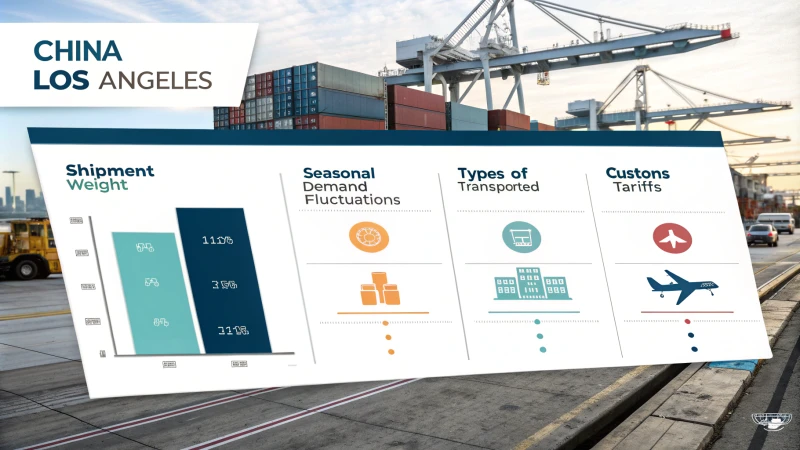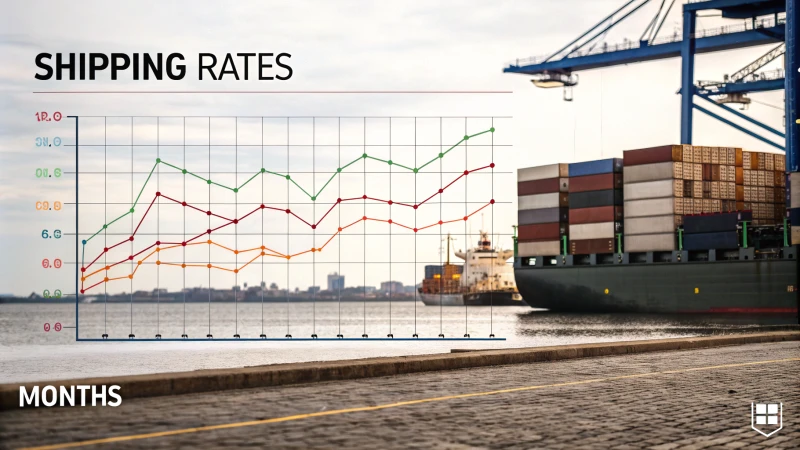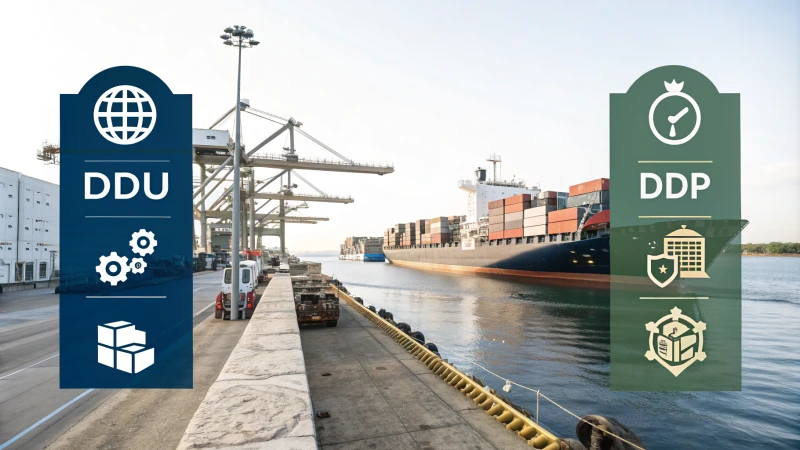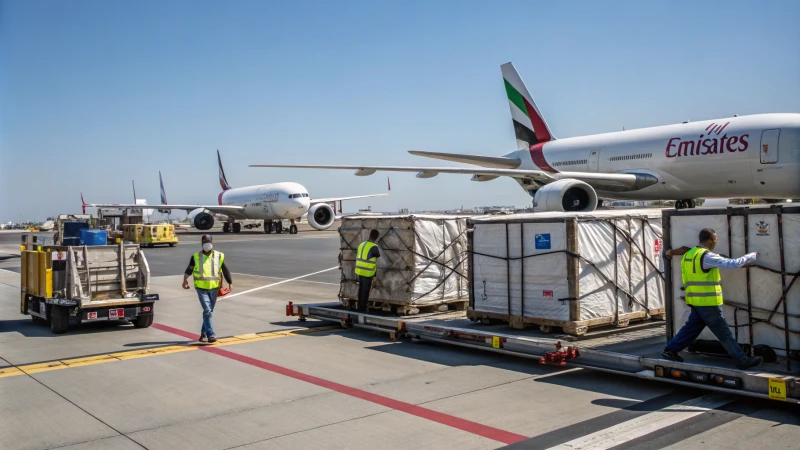Are you currently organizing a shipment from China to Los Angeles? I really understand how stressful this process feels!
The cost of air shipping from China to Los Angeles changes a lot. Shipment weight, volume and season affect the price. Off-peak times usually cost between USD 3.5 and 9 for each kilogram. Peak season prices are often between USD 3.8 and 9.8 per kilogram. Contact us for asking the latest prices.
When I began my e-commerce journey, I felt surprised by how much air freight costs varied. I remember going through many quotes and trying to understand why prices changed so often. Air freight costs from China to Los Angeles change a lot. Shipment weight and the season affect prices. During slower times, rates might be between USD 3.5 and 9 per kilogram. In peak seasons, prices probably rise to USD 3.8 and 9.8 per kilogram. For correct pricing, contacting your freight forwarder for the latest rates really helps.
Air freight costs from China to LA can range from $3.5 to $9/kg.True
This claim reflects the variable pricing based on shipment weight and seasonality.
Peak season air freight rates exceed $9.8 per kilogram.True
During peak times, air freight rates increase, potentially exceeding $9.8 per kg.
What factors influence air freight costs from China to Los Angeles?
Let's explore air freight costs. Understanding these expenses is crucial for anyone bringing goods from China to Los Angeles. Many factors contribute to these costs. They can greatly affect a budget. They might even ruin it.
Air freight costs from China to Los Angeles depend on several important things꞉ shipment weight, seasonal demand changes, type of goods transported and customs tariffs. These factors impact costs. Understanding these elements really helps in effective budgeting. People might save significant money.

Weight and Charge Weight
A huge surprise was seeing how weight affects air freight expenses. It sounds simple, but it's not just about the shipment's actual weight. Once, I shipped a big batch of fashion accessories. Calculating the charge weight was crucial, using both real and size-based (volumetric) weights. A higher weight reduces the cost per kilogram. This lowers expenses.
| Charge Weight | Air Freight Cost per KG | Delivery Time |
|---|---|---|
| 21-50kg | USD 8.2-9 | 4-6 working days |
| 51-100kg | USD 7-8 | 4-6 working days |
| 101-500kg | USD 5.5-6.8 | 4-6 working days |
| 501-1000kg | USD 4.8-5.8 | 4-6 working days |
| >1000kg | USD 3.5-5 | 4-6 working days |
For more on calculating charge weights, this guide1 was really helpful.
Seasonal Fluctuations
Timing really changes shipping expenses. Peak seasons like holidays push cargo space demand sky-high. Prices then rise a lot. When I planned shipments for the holiday season, I saw rates rise sharply.
Peak Season Rates:
| Charge Weight | Air Freight Cost per KG | Delivery Time |
|---|---|---|
| 21-50kg | USD 8.5-9.8 | 5-8 working days |
| 51-100kg | USD 7-8.5 | 5-8 working days |
| 101-500kg | USD 5-7.5 | 5-8 working days |
| 501-1000kg | USD 4.5-6.5 | 5-8 working days |
| >1000kg | USD 3.8-6.2 | 5-8 working days |
Off-season rates drop significantly, making it a strategic time for saving money while managing inventory.
For ideas on handling seasonal pricing, check out this article2.
Type of Goods
Product type affects costs too. Special handling or packaging, especially for hazardous items or perishables, adds costs that e-commerce owners should remember to avoid surprises.
For info on shipping various products, see our shipping regulations3.
Tariffs and Customs Fees
Tariffs and customs fees are very important when importing from China to the U.S.. Knowing if your price is DDU (Delivery Duty Unpaid) or DDP (Delivery Duty Paid) impacts your budget a lot.
Chinese product tariffs range widely - 0% to 40% based on category; understanding these rates helps predict costs accurately.
For details on customs and freight costs, visit this customs guide4.
Conclusion
Understanding air freight costs from China to Los Angeles seemed hard at first but by figuring out these factors and applying them to my shipping practices, I have been able to budget wisely! Every shipment teaches me something new as I continue improving my logistics as my business grows!
Higher weight shipments incur lower air freight costs per kg.True
As the weight of the shipment increases, the cost per kilogram decreases, making heavier shipments more economical for businesses.
Air freight costs are unaffected by seasonal demand changes.False
Air freight costs fluctuate significantly during peak seasons due to increased demand for cargo space, impacting pricing strategies.
How do seasonal changes affect shipping rates?
Do you ever think about why shipping prices rise so much during the holidays? People who work in logistics know that these changes happen every year. This knowledge helps them control costs better. It really is important.
Seasonal changes affect shipping rates. Costs go up during peak demand periods. Limited carrier capacity and high demand for goods drive this increase. Holidays or special sales events usually lead to these periods. Shippers probably face higher expenses.

Understanding Seasonal Demand
Seasonal changes play a critical role in determining shipping rates. As demand for products fluctuates throughout the year, shipping costs often reflect these variations. For example, during the holiday season, demand surges for various goods, leading to increased shipping rates due to limited carrier capacity.
This spike in demand can significantly impact rates, especially for air freight, where costs can increase by 10-20% compared to off-peak seasons. To manage costs effectively, businesses should analyze seasonal trends5 to anticipate changes in shipping needs.
Comparison of Off-Peak vs. Peak Shipping Rates
To illustrate the impact of seasonal changes, consider the following table comparing off-peak and peak shipping rates based on charge weight:
| Charge Weight | Off-Peak Rate (USD/kg) | Peak Rate (USD/kg) | Delivery Time (Days) |
|---|---|---|---|
| 21-50 kg | 8.2 - 9 | 8.5 - 9.8 | 4 - 6 |
| 51-100 kg | 7 - 8 | 7 - 8.5 | 4 - 6 |
| 101-500 kg | 5.5 - 6.8 | 5 - 7.5 | 4 - 6 |
| 501-1000 kg | 4.8 - 5.8 | 4.5 - 6.5 | 4 - 6 |
| >1000 kg | 3.5 - 5 | 3.8 - 6.2 | 4 - 6 |
This table reveals that shipping costs can rise significantly during peak times, particularly for lighter cargo where the price per kilogram is most affected. Such insights are crucial for logistics planning and can guide decisions about inventory management and supplier agreements.
Factors Influencing Seasonal Shipping Costs
Several factors contribute to the changes in shipping rates during different seasons:
- Carrier Capacity: During peak seasons, carriers often face capacity constraints, driving up prices.
- Demand Fluctuations: Seasonal products or sales events increase demand, leading to higher shipping costs.
- Tariff Changes: International tariffs can also vary seasonally, particularly for imports from countries like China. The difference in DDU and DDP pricing is often influenced by seasonal tariffs which can fluctuate by as much as 40% due to these tariffs.Explore tariff impacts6.
Strategies for Managing Seasonal Shipping Costs
To mitigate the impact of seasonal changes on shipping rates, businesses can employ several strategies:
- Advance Planning: Identify key sales periods and plan shipments accordingly to avoid peak pricing.
- Diversify Shipping Options: Consider using a mix of air and sea freight to balance cost and delivery speed.
- Negotiate Rates: Building long-term relationships with carriers can lead to better rate negotiations during high-demand periods.
For further insights into managing your logistics strategies effectively, check out this resource on cost-saving shipping strategies7.
Shipping rates increase during peak seasons due to high demand.True
During peak seasons, such as holidays, demand surges, leading to higher shipping costs due to limited carrier capacity.
Air freight costs can rise by 20% in off-peak seasons.False
Air freight costs typically increase by 10-20% during peak seasons, not off-peak, due to higher demand and capacity constraints.
What are the differences between DDU and DDP pricing?
Understanding international shipping might feel very overwhelming. Pricing models like DDU and DDP can really confuse people. Let’s learn about these concepts together. Discover how they probably affect your e-commerce business.
DDU (Delivered Duty Unpaid) requires buyers to pay import taxes when goods arrive. DDP (Delivered Duty Paid) includes all costs paid by the seller before shipping. Buyers have no additional charges. Differences between these terms are very important. Logistics planning works better with this understanding.

Understanding DDU and DDP Pricing Models
When I started in e-commerce, I felt really confused about international shipping costs. The terms DDU (Delivered Duty Unpaid) and DDP (Delivered Duty Paid) appeared often. I knew I should understand these to avoid problems in logistics planning.
What is DDU Pricing?
Let’s start with DDU. This model means the seller delivers goods without paying import duties or taxes. The buyer handles customs duties upon arrival. Here’s what this involves:
- Buyers handle customs clearance.
- Extra costs might pop up upon arrival.
- Delivery may delay if customs duties are unpaid.
I remember receiving a shipment with an unexpected customs fee! It was a shock. This taught me that while DDU might lower initial costs, unexpected expenses may arise. These surprise expenses really can strain your budget.
What is DDP Pricing?
DDP is different. The seller covers all costs, like delivery, duties, and taxes upfront. This involves:
- Sellers manage customs clearance.
- Buyers pay no extra charges when receiving goods.
- Clarity on total costs is really improved.
I found DDP pricier at the start, but it gave peace of mind. Managing my budget became much easier without worrying about hidden fees.
Key Differences Between DDU and DDP
| Aspect | DDU | DDP |
|---|---|---|
| Cost Responsibility | Buyer pays duties and taxes | Seller pays all duties/taxes |
| Customs Clearance | Buyer is responsible | Seller handles clearance |
| Predictability | Less predictable costs | More predictable overall costs |
| Risk of Delays | Higher risk of delays | Lower risk of delays |
| Ideal For | Cost-sensitive buyers | Buyers preferring simplicity |
Choosing between DDU and DDP impacts your logistics strategy a lot. Frequent shipping to areas with high tariffs highlights the need to understand these costs.
Real-World Implications
In practice, think about a U.S.-based e-commerce store that sources products from China. Recent trade policy changes increased tariffs under DDU, resulting in price differences ranging from 0-40% compared to DDP prices appearing. Understanding these differences affects the financial outcomes significantly.
By examining scenarios and my own experience, I’ve realized businesses should decide which model fits their needs best. Learning more about international shipping strategies might help you explore best practices in logistics8.
DDU pricing requires buyers to pay import duties upon arrival.True
In DDU, buyers are responsible for customs duties and taxes once goods arrive, unlike DDP where the seller covers these costs.
DDP pricing model offers more predictable shipping costs.True
With DDP, all charges are paid by the seller upfront, ensuring buyers know their total costs without surprises.
Conclusion
Air freight from China to Los Angeles varies significantly by weight and season, with costs ranging from $3.5 to $9 per kg off-peak and higher during peak times.
-
Explore various factors affecting air freight costs to optimize your shipping budget effectively. ↩
-
Learn about seasonal fluctuations that impact shipping rates significantly during peak times. ↩
-
Understand the implications of tariffs and customs on your import expenses. ↩
-
Discover regulations on shipping different types of goods to avoid unexpected charges. ↩
-
This link offers valuable insights into how seasonal trends can influence your logistics strategy, helping you prepare for cost fluctuations. ↩
-
Learn about how tariffs change seasonally and their effects on international shipping costs, essential for budget planning. ↩
-
Discover effective strategies for managing your logistics during high-demand seasons to keep costs down. ↩
-
This resource will guide you through best practices in logistics management, which is crucial for efficient shipping operations. ↩




